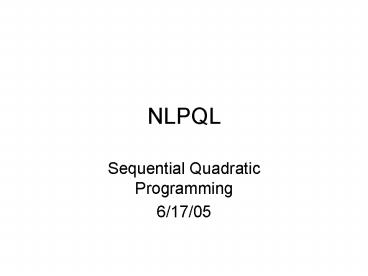NLPQL PowerPoint PPT Presentation
1 / 23
Title: NLPQL
1
NLPQL
- Sequential Quadratic Programming
- 6/17/05
2
References
- Schittkowski, K. Solving Nonlinear Least Squares
Problems by a General Purpose SQP method in
Trends in Mathematical Optimization. - Schittkowski, K. NLPQL A fortran subroutine
solving constrained non linear programming
problems. Annals of Operations Research Vol 5. - NLPQL User Manual
- Optimization Concepts and Applications in
Engineering by Belegundu.
3
Sequential Quadratic Programming
- IMHO This is the algorithm of choice for smooth
constrained optimization problems. (i.e.
continuously differentiable) - Prefered by Vanderplaats, Onwubiko, Belegundu,
Rao, Lasdon - Works with both feasible and infeasible initial
design points. - Works well with equality constraints.
- Requires fewer function evaluations then GRG
- Superior rate of convergence
4
NLPQL
- Developed and constantly improved by Prof. Dr. K.
Schittkowski at University of Bayreuth. First
version in 1981. Latest version from 2000. - Probably most heavily tested implementation with
over 900 test cases. - Hundreds of commercial applications. Customers
include General Electric, Rolls-Royce, Siemens,
BMW, Dow Chemical.
5
NLPQL Formulation
iSIGHT needs to translate its constraints from lt
0 as stored internally to gt 0 NLPQL uses F(X)
for Objective value. X for design values G for
constraint values
6
Search Direction
- In Steepest Descent and GRG the search direction
was found using gradient information. - For SQP, the search direction is found by solving
a subproblem with a quadratic objective and
linear constraints. The quadratic objective is an
approximation to the Lagrangian.
7
Getting the Search Direction
8
Line Search
9
NLPQL Implementation
- Generates a sequence of quadratic programming
subproblems obtained by a quadratic approximation
of the Lagrangian function and linearization of
constraints. - Second order information is updated by
quasi-Newton formula (similar to BFGS) - Line search used to stabilize method. Only two
user parameters are maximum number of iterations
and desired final accuracy. The final accuracy
should not be smaller than minimum absolute
gradient step. - As a user, you can not tune algorithm. You can
primarily tune the problem formulation. - Insure program is scaled.
- Verify that your gradients are of the right
tolerance. - Start the algorithm from multiple points.
10
NLPQL within iSIGHT
- Engineous has limited a line search to a maximum
of 10 evaluations. You cannot change this. - The print level is 4 for full print out. You
cannot change this. - Diagnostics are minimal. Look at
Karush-Kuhn-Tucker conditions and see if it is
approaching zero. - Lagrangian multipliers suggest constraintsto
relax for greatest gain. Worth investigatingwith
a Tradeoff Analysis - If the objective or gradient values are greater
then SCBOU (1000) the NLPQL automatically scales
by 1/sqrt(value)
11
NLPQL Output File Header
12
Typical NLPQL output for an iteration
13
Final NLPQL Output Summary
14
NLPQL Termination
15
NLPQL Termination Reasons
- If you have scaled the model and are using a good
finite step size and multiple starting points
then 3 possibilities are - Termination parameter is too small.
- The constraints are contradicting with an empty
set of feasible solutions. - Constraints are feasible but some are degenerate.
16
Basic Parameters
17
Advanced Parameters
18
Lab
- Objectives
- Gain experience using NLPQL
- Analyze NLPQL output for convergence analysis
- Use Lagrangian multipliers for sensitivity
analysis - Note iSIGHT Glitch that you need to exit iSIGHT
to have NLPQL status written to log file. You can
then view log file in your favorite text editor.
19
Lab
- Task 1
- Run the cantilevered beam, beam_Tcl.desc with
NLPQL. Takeall defaults. Use no problem scaling.
Answer the following questions - What was the optimum objective value?
- How many function evaluations did it take?
- How many SQP iterations were needed?
- Plot the Kuhn Tucker value for each iteration.
- What was the reason for termination?
20
Lab Continued
- Task 2
- Run the cantilevered bean again but this time
provide a scale factorfor vol of 100000 and a
scale factor of 5 for b1-b5 and a scale factorof
40 for h1-h5. (Note These should have been the
same settings that you used for exterior
penalty). - What was the optimium objective value
- How many function evaluations did it take?
- What was the reason for termination?
- Compare the number of function evaluations with
that of exteriorpenalty. Which is better? - Review the Lagrangian Multipliers. Which
constraint can be relaxedfor the greatest gain
in an objective? - Verify your analysis by running a tradeoff
analysis.
21
Lab Continued
- Task 3 Lets try a different problem. The speed
reducer is anotherclassic standard optimization
test problem. The problem was takenfrom
Engineering Optimization Theory and Practice by
Rao. The problemis described on the next two
slides. - The problem has already been coupled in the
description file,GearTrain_Tcl.desc. - Review the standard problem formulation in the
Parameters window.The formulation does not have
its design variables, objectives andconstraints
normalized. - Run the optimization without a scaled formulation
and with a scaled formulation. Compare the
optimization value and the number offunction
evaluations for both. (This problem really shows
the benefitsof scaling.) - Review the Lagrangian multipliers of the scaled
solution. Which are the top two output
constraints to consider for relaxation and what
would thebenefit be? - From the lagrangian multipliers, which two input
constraints should be consideredfor relaxation
and what would the benefit be?
22
(No Transcript)
23
(No Transcript)

